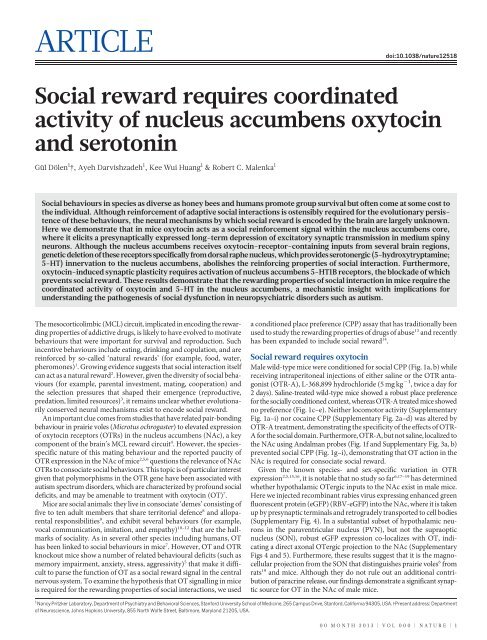Feature Article - Nature Magazine
Feature Article - Nature Magazine
Feature Article - Nature Magazine
You also want an ePaper? Increase the reach of your titles
YUMPU automatically turns print PDFs into web optimized ePapers that Google loves.
ARTICLE<br />
doi:10.1038/nature12518<br />
Social reward requires coordinated<br />
activity of nucleus accumbens oxytocin<br />
and serotonin<br />
Gül Dölen 1 {, Ayeh Darvishzadeh 1 , Kee Wui Huang 1 & Robert C. Malenka 1<br />
Social behaviours in species as diverse as honey bees and humans promote group survival but often come at some cost to<br />
the individual. Although reinforcement of adaptive social interactions is ostensibly required for the evolutionary persistence<br />
of these behaviours, the neural mechanisms by which social reward is encoded by the brain are largely unknown.<br />
Here we demonstrate that in mice oxytocin acts as a social reinforcement signal within the nucleus accumbens core,<br />
where it elicits a presynaptically expressed long-term depression of excitatory synaptic transmission in medium spiny<br />
neurons. Although the nucleus accumbens receives oxytocin-receptor-containing inputs from several brain regions,<br />
genetic deletion of these receptors specifically from dorsal raphe nucleus, which provides serotonergic (5-hydroxytryptamine;<br />
5-HT) innervation to the nucleus accumbens, abolishes the reinforcing properties of social interaction. Furthermore,<br />
oxytocin-induced synaptic plasticity requires activation of nucleus accumbens 5-HT1B receptors, the blockade of which<br />
prevents social reward. These results demonstrate that the rewarding properties of social interaction in mice require the<br />
coordinated activity of oxytocin and 5-HT in the nucleus accumbens, a mechanistic insight with implications for<br />
understanding the pathogenesis of social dysfunction in neuropsychiatric disorders such as autism.<br />
The mesocorticolimbic (MCL) circuit, implicated in encoding the rewarding<br />
properties of addictive drugs, is likely to have evolved to motivate<br />
behaviours that were important for survival and reproduction. Such<br />
incentive behaviours include eating, drinking and copulation, and are<br />
reinforced by so-called ‘natural rewards’ (for example, food, water,<br />
pheromones) 1 . Growing evidence suggests that social interaction itself<br />
can act as a natural reward 2 . However, given the diversity of social behaviours<br />
(for example, parental investment, mating, cooperation) and<br />
the selection pressures that shaped their emergence (reproductive,<br />
predation, limited resources) 3 , it remains unclear whether evolutionarily<br />
conserved neural mechanisms exist to encode social reward.<br />
An important clue comes from studies that have related pair-bonding<br />
behaviour in prairie voles (Microtus ochrogaster) to elevated expression<br />
of oxytocin receptors (OTRs) in the nucleus accumbens (NAc), a key<br />
component of the brain’s MCL reward circuit 4 . However, the speciesspecific<br />
nature of this mating behaviour and the reported paucity of<br />
OTR expression in the NAc of mice 2,5,6 questions the relevance of NAc<br />
OTRs to consociate social behaviours. This topic is of particular interest<br />
given that polymorphisms in the OTR gene have been associated with<br />
autism spectrum disorders, which are characterized by profound social<br />
deficits, and may be amenable to treatment with oxytocin (OT) 7 .<br />
Mice are social animals: they live in consociate ‘demes’ consisting of<br />
five to ten adult members that share territorial defence 8 and alloparental<br />
responsibilities 9 , and exhibit several behaviours (for example,<br />
vocal communication, imitation, and empathy) 10–12 that are the hallmarks<br />
of sociality. As in several other species including humans, OT<br />
has been linked to social behaviours in mice 7 . However, OT and OTR<br />
knockout mice show a number of related behavioural deficits (such as<br />
memory impairment, anxiety, stress, aggressivity) 5 that make it difficult<br />
to parse the function of OT as a social reward signal in the central<br />
nervous system. To examine the hypothesis that OT signalling in mice<br />
is required for the rewarding properties of social interactions, we used<br />
a conditioned place preference (CPP) assay that has traditionally been<br />
used to study the rewarding properties of drugs of abuse 13 and recently<br />
has been expanded to include social reward 14 .<br />
Social reward requires oxytocin<br />
Male wild-type mice were conditioned for social CPP (Fig. 1a, b) while<br />
receiving intraperitoneal injections of either saline or the OTR antagonist<br />
(OTR-A), L-368,899 hydrochloride (5 mg kg 21 , twice a day for<br />
2 days). Saline-treated wild-type mice showed a robust place preference<br />
for the socially conditioned context, whereas OTR-A treated mice showed<br />
no preference (Fig. 1c–e). Neither locomotor activity (Supplementary<br />
Fig. 1a–i) nor cocaine CPP (Supplementary Fig. 2a–d) was altered by<br />
OTR-A treatment, demonstrating the specificity of the effects of OTR-<br />
A for the social domain. Furthermore, OTR-A, but not saline, localized to<br />
the NAc using Andalman probes (Fig. 1f and Supplementary Fig. 3a, b)<br />
prevented social CPP (Fig. 1g–i), demonstrating that OT action in the<br />
NAc is required for consociate social reward.<br />
Given the known species- and sex-specific variation in OTR<br />
expression 2,5,15,16 , it is notable that no study so far 6,17–19 has determined<br />
whether hypothalamic OTergic inputs to the NAc exist in male mice.<br />
Here we injected recombinant rabies virus expressing enhanced green<br />
fluorescent protein (eGFP) (RBV-eGFP) into the NAc, where it is taken<br />
up by presynaptic terminals and retrogradely transported to cell bodies<br />
(Supplementary Fig. 4). In a substantial subset of hypothalamic neurons<br />
in the paraventricular nucleus (PVN), but not the supraoptic<br />
nucleus (SON), robust eGFP expression co-localizes with OT, indicating<br />
a direct axonal OTergic projection to the NAc (Supplementary<br />
Figs 4 and 5). Furthermore, these results suggest that it is the magnocellular<br />
projection from the SON that distinguishes prairie voles 6 from<br />
rats 19 and mice. Although they do not rule out an additional contribution<br />
of paracrine release, our findings demonstrate a significant synaptic<br />
source for OT in the NAc of male mice.<br />
1 Nancy Pritzker Laboratory, Department of Psychiatry and Behavioral Sciences, Stanford University School of Medicine, 265 Campus Drive, Stanford, California 94305, USA. {Present address: Department<br />
of Neuroscience, Johns Hopkins University, 855 North Wolfe Street, Baltimore, Maryland 21205, USA.<br />
00 MONTH 2013 | VOL 000 | NATURE | 1



